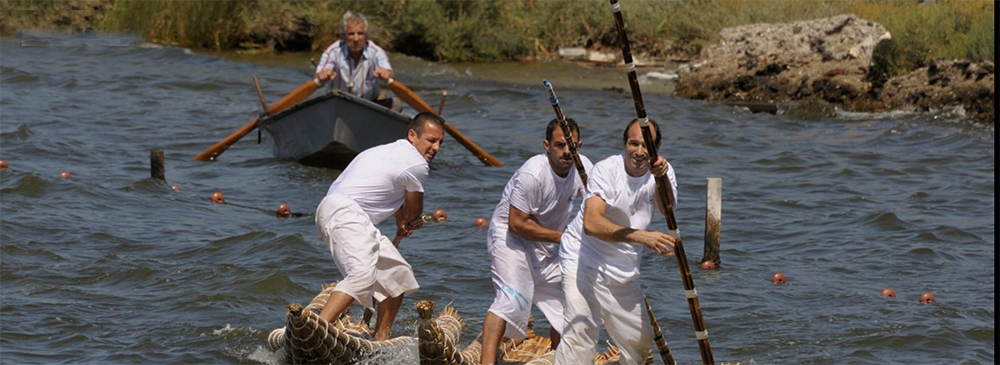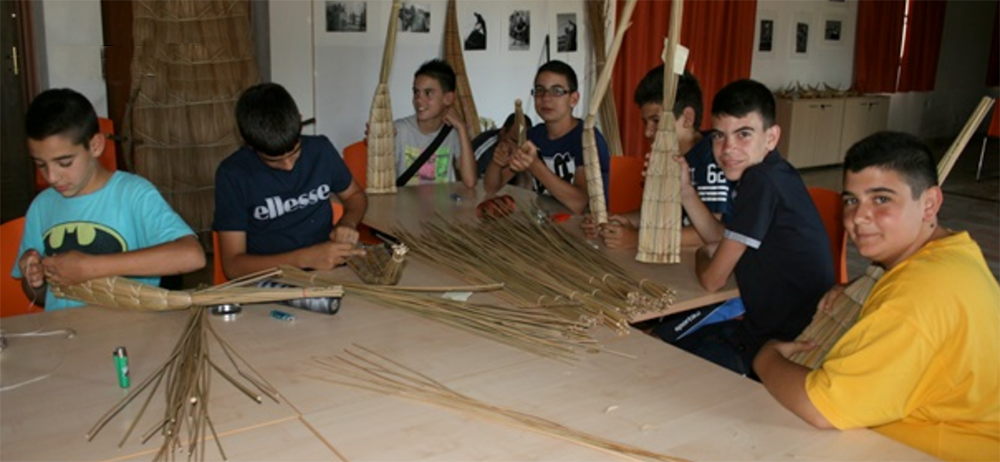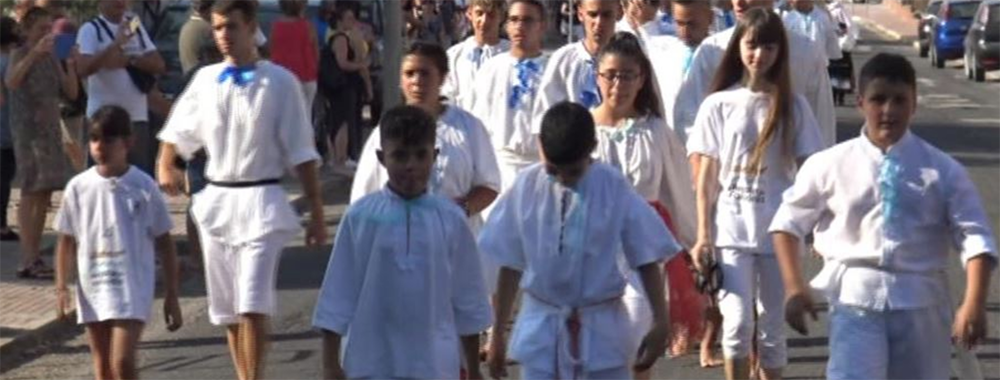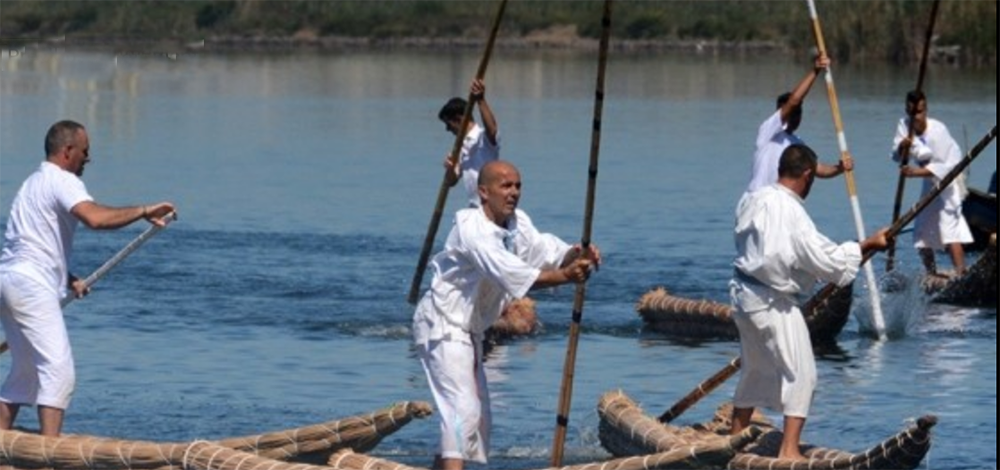"I like rowing, even if it is difficult to keep in balance sometimes. And I like the pond, seeing the birds and the fish, and the plants also", says Marta Casula, 9 year-old, leaving for a moment the small model of fassone she is building. Around her the other students of the construction and sailing school of the maestro Marco Pili and his son Davide, focused on tying the hay stalks firmly in the weft that makes up the ascending line of the keel.
Marta thus takes back an object that populates the ponds of the Oristano area from the Nuragic age, a simple woven marsh hay making a fishing boat also used by Phoenicians and Romans. "It was 2007 when we decided to set up the school", says Rimondo Cadoni, municipal councilor of Santa Giusta and one of the major promoters of the regatta that for years now has attracted thousands of tourists to the small town near Oristano. "The school is a flagship for the administration. It represents the continuity of an ancient tradition, renewed every year with the regatta. This year seven of the participants came from the school, and soon we would like to see a women-only competition".
The traditional building that houses the school in the historic center of Santa Giusta is not only a laboratory but also a museum of fishing tradition. Nets, pots and “bertivelli”, a splendid labyrinth placed in the pond to catch eels, crabs and shrimps. Outside, beyond the clearing, the canopy under which old and new fassoni rest, imposing, ancestral and still weighed down by the water absorbed during the last sailings.
"We practice navigation when the weather conditions allow it", explains Silvia Statzu, 14 year-old, a candidate to participate in the next competition, the first female to represent the tradition born from an intuition of Ireneo Ledda, who died in May and was the first, forty years ago, to see the role of the fassoni and the regatta in the promotion of the territory. "I really don't mind winning, my goal is to compete with adults. I've been attending school for seven years. By now I am able to sail and build it”. "It immediately seemed like a wonderful idea", says Costantina Tuveri, mother of Marta and Matteo. "It's a way to preserve the tradition, to take part in a story. Above all, children have fun", she adds.
"The course lasts for about three months, and begins with the closure of the schools. The practice takes place on a ‘ciu’, the traditional flat-bottomed fishing boat. The fassone must be put in water as little as possible. The boys start with the oars, and only later I teach them how to conduct the ‘cantoi’, the pole" explains maestro Pili. Construction begins with collecting marsh hay, "on nights that are not of full moon, because this is what tradition suggests, and we respect it". Then the drying, which has to last for three days. The hay is then braided to form long clusters that make up the keel, formed around the central axis by up to nine decks. Compared to the ancient fishing model the banks are lower. Vegetable stranding has been replaced by nylon. The oarlocks, born to be used in the regatta, are of olive or heather.
"I started getting interested in the fassoni at the age of twenty", says Pili. "My brother Antonello and I studied the object, we collected stories and suggestions of the village elders. In Santa Giusta the art of construction was dead, it started again. The boys give me enormous satisfactions. They are our future, the future of our culture".

The Island made of mussels in Corru Mannu's pond began to be populated by birds
Little tern, common tern, sandwich tern, rosy gull and black-winged stilt are some of the bird species that have found a home in Corru Mannu in recent weeks. Thanks to…

Sardinian Wetlands, the best way to protect them is "to manage them"
Cagliari, 04.02.2023 – Le zone umide sono ecosistemi acquatici sempre più rilevanti, conoscerli meglio è il primo passo per tutelarli, ma non è tutto. “Serve uno strumento di gestione” per…

The II D from Terralba Institute visited the Old Tower of Marceddì as prize for Terre d'Acqua school contest 2022
Learning about the role of these precious and very important ecosystems, as well as the specificities of the large wetland area of Oristano. In recent days we have accompanied the…

Maristanis was showcased at the Ramsar COP 14 on wetlands during a side event
The 14th meeting of the Ramsar Wetlands Conference (COP14) was held in Geneva from 5 to 13 November 2022, simultaneously also in Wuhan, China. At the International Conference Center in Geneva (CICG) all…

Learning from the Maristanis's model in the ENSERES's visit exchange
Two days to study an integrated management model of marine-coastal systems, two days to strengthen ties and develop new strategies for a sustainable future of the Mediterranean. The Italian stage…

A step forward for the Maristanis project, towards the Regional Park of wetlands in Sardinia
The Municipal Council of Oristano, on the proposal of the Councilor for the Environment Maria Bonaria Zedda, has launched the participatory process and the preparatory actions necessary for the establishment…

Evaluating ecosystem services by the TESSA Methodology in Arborea
How to understand the effects on natural capitals and actual and potential state changes of individual sites important in promoting decisions to support both biodiversity conservation and ecosystem service provision?

Terre D'Acqua 2022, the winners of the school contest within the Maristanis Project
With 87 works, of which 84 in the drawing category and 3 in the comics category, the MEDSEA Foundation's Terre D’Acqua 2022 Competition ends. The school contest took place from February…

The Sardinian farms met in Arborea under the sign of Sustainability
This is the year of relaunch for the La Fiera dell’agricoltura di Arborea (Agricultural Fair of Arborea), one of the most important thematic fairs in Sardinia that promotes the productive, agro and…

Maristanis in the news: Rai and Italia 1 dedicated ample space to the Maristanis Project
The Italian press gave ample space to the Maristanis project in recent months, the Oristanese wetlands and its most important project Maristanis were told in various national and local television reports on…

The winner of the World Wetlands Day in Sardinia 2022 Contest
With a picture taken in the Oristanese lagoons representing a group of flamingos and the sentence "They come / They come back / Sometimes they stop / Like nomads /…

Over 700 visitors for the World Wetlands Day Calendar
Over 700 visitors in the World Wetlands Day collective calendar, put together by the MEDSEA Foundation, as part of the Maristanis project last February, with the aim of promoting the precious…

The World Wetlands Day 2022 in Sardinia lasts a month, the events Calendar
As every year, the World Wetlands Day on the anniversary of the RAMSAR convention (of 1971, Feb. 2nd) calls and Sardinia, in particular the Oristanese area, replies within the Maristanis project that…

World Wetlands Day in Sardinia, from 2 to 27 February join the competition #WWDSardegna on Instagram
In the occasion of the World Wetlands Day which celebrates ponds and lagoons in the world next February 2, the MEDSEA foundation launches the contest on wetlands in Sardinia with the hashtag #WWDSardegna to…

MAVA Steering Committee in Provence: Sardinia was promoted with the Maristanis project
MEDSEA foundation, which has been carrying out the Maristanis project in the Oristano area in Sardinia since 2017, attended last week the yearly meeting of the MAVA steering committee. The session took place from 16 to 17 December 2021 in Châteauneuf-le-Rouge, in the Provence-Alpes-Côte d'Azur region, and gathered together the…

Terre d'Acqua, a wetlands school competition for students in the Oristanese
On February 2, the World Wetlands Day will be celebrated once again the Oristanese wetlands region. To recall the central role of wetlands in addressing climate and environmental crisis and to raise awareness of the importance of these basins especially in this west coast side…
- 1
- 2
- 3
- 4




